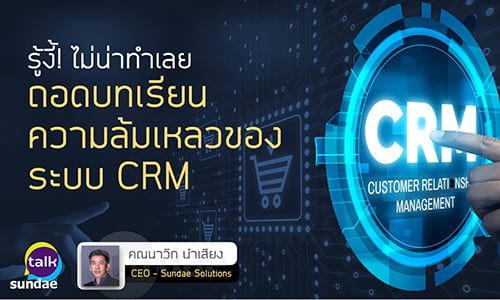Learn from the failure of the CRM system [en]
- March 30, 2022
- Posted by: Siriluck Sukitphittayanon
- Category: Articles-EN


Your CRM platform is central to both sales, marketing, service, and the interactions or conversations you have with leads and customers. The CRM you use can create or delete your sales activities. Whether it’s creating a streamlined lead database that you can use to understand how and when you’re engaging with customers and what your success is. Or it can mess up data that doesn’t affect your sales and marketing and makes sales analytics a mess and a headache when it’s time to review your pipeline.
One of the reasons why a CRM doesn’t work as
intended occurs early on when you first start using it.
As we’ve said, there are tons of CRMs to choose from. And each software has its pros and cons, but they are different. With our experience, We can walk you through which software is right for your business. To truly market your sales and services.
These are the most common problems we encounter.
1. Businesses don’t know why they need a CRM.
This is a great troubleshooter on every project, not just CRM. Businesses need CRM because other people have it but don’t really understand why. They’ve read or heard it works (which it does), but they don’t really know what CRM will do for them and fit into their business.
This created a few problems.
- You can’t put in place a CRM system properly if you don’t know how it will fit together.At most, you’ll end up with something that’s part of the job, but not something that you’ll put to good use.
- From an investment standpoint, you can’t figure out if the implementation was successful or not. Before you can implement a CRM, you need to understand its purpose.
Do you want a clearer picture of your customer interactions?
Do you need a customer repository that allows you to segment them easily?
Do you want to keep reliable customer data because your paper-based storage are not good for analyzing?
2. Lack of employees who know and need
This is another major problem in adopting new technology in business. The manager decided to bring the new system in and no employee knew about it until it was expected to be implemented.What you’ll often find is that employees don’t understand the benefits or why they’re changing. They will stick to the way they used to, which means not all customer data runs fully in your CRM and you will create another data warehouse that is really useless.
3. Lack of understanding about integration
Again, if you’re bringing in a new system but plan to keep some of your old system, you’ll need to understand how they connect.
For CRM, you need to know how easy it is to integrate your website with your CMS, as well as your sales platforms like E-commerce, Contact Center, Chat, etc.
Can you sync these together to create an all-in-one sales and marketing tool? Or will you risk losing data from forms filled out on your website because they are out of sync with your CRM?
4. You’re running a CRM for a specific part of your business.
For most organizations, the sales team isn’t the only channel for sales that exists in your business—in fact, everyone who works for the company. When other employees meet or talk to customers, they act like salespeople as well. Your software-based customer service department may assist with cross-selling while serving customers. Your call center team may also need to handle sales over the phone. When they interact with customers, they need to know what to do and where the information needs to go. If you’ve implemented a CRM and limited it to a few departments or people, you’ll never get the full potential out of a CRM.
5. Your CRM does not support future technologies.
You might think that implementing a CRM is just a one-time setup and it can be used forever. The truth is that CRM implementation is an ever-evolving process. That’s because as your business grows and your processes may change to adapt to your new environment.
6. Users are not trained to use them properly.
People are one of the most important factors in a CRM implementation failure if the end user is not trained on how to use it or understand what it is for. The system will not be able to work fully. That’s why it’s important when planning your CRM implementation that you need to account for skill gaps and the training that needs to be done with your team ready for launch date.
We’ve found the benefit of training is training a few expert users, known as “Trainers (Training for the Trainers)”, in the business to train first. And when they start to see success using CRM, you can be sure the rest of the team will follow suit.
7. Choosing the wrong CRM software
Again, this is a failure to plan and not to understand CRM properly.
Your CRM software will depend on the size and type of business, how you manage your customer interactions, and many other factors. There may not be a need for complex and highly customized CRM software.
On the other hand, if a large organization uses a CRM software that is too small, lacks the flexibility to change programs, and is insufficiently complex, it may not be able to support complex business needs, such as the inability to store or segment customer data as on-demand and automatically
The best thing about CRM software selection is understanding the needs of the business, categorizing it as necessary and important, selecting the software from at least 2-3 demos of CRM software or service providers.
